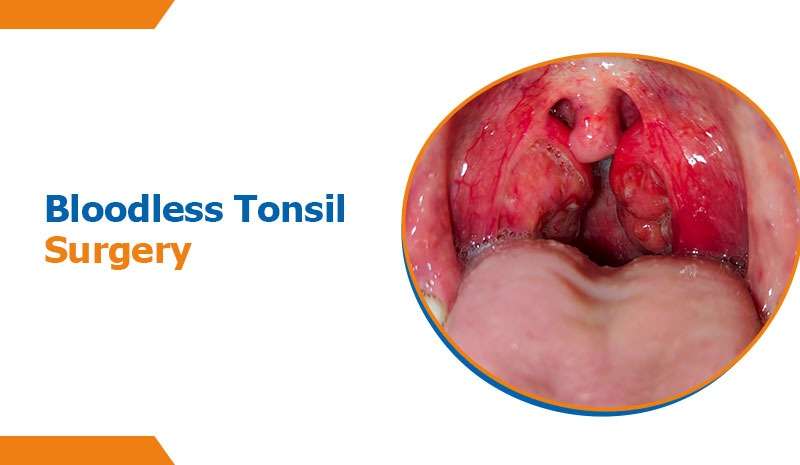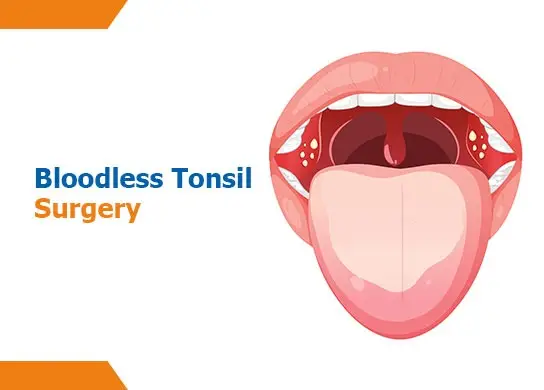The thought of your child undergoing surgery is enough to send chills down any parent’s spine. But what if there were a way to make the procedure safer, cleaner, and almost no bleeding? That’s exactly what bloodless tonsil surgery offers — and it’s changing the way many doctors approach tonsil removal.
A Modern Alternative to Traditional Surgery
In traditional tonsillectomy, the tonsils are removed using a scalpel or surgical scissors. While the procedure is safe and widely practiced, it usually results in more tissue damage, visible bleeding during the operation, and a longer recovery period.
Bloodless tonsil surgery, on the other hand, uses advanced techniques like:
- Coblation (Cold Ablation)
- Laser Tonsillectomy
- Radiofrequency Ablation (RFA)
These methods use low-temperature energy or focused light to dissolve or vaporize the tonsil tissue instead of cutting it. Because the tissue is sealed as it’s removed, there’s little to no bleeding, and post-surgical pain is significantly reduced.
Why Is It Called “Bloodless”?
The word “bloodless” doesn’t imply zero blood, but in comparison to the conventional methods, there is minimal or no bleeding, especially in the case of the actual surgery. That is a welcome relief to the surgeons and parents, especially in the case of young children whose small bodies are unable to tolerate much blood loss.
Why Is It Gaining Popularity Among Parents?
No parent wants their child to go through pain, especially when it’s avoidable. That’s one of the main reasons why bloodless tonsil surgery is becoming the preferred choice for families around the world, e anche in India.
Compared to traditional tonsil removal, this modern technique offers a gentler, safer, and faster path to recovery.
Less Pain, Less Trauma
One of the biggest concerns for parents is post-operative pain. With traditional surgery, children may experience intense throat discomfort for several days, making it hard to eat, drink, or sleep.
Bloodless techniques like coblation or radiofrequency use low-heat energy to break down the tonsil tissue. This causes far less trauma to surrounding areas, which means:
- Less sore throat pain
- Reduced need for strong painkillers
- Fewer sleepless nights (for both child and parent!)
Faster Recovery Time
With less bleeding and trauma, the recovery process is naturally quicker. Most children:
- Resume soft foods within 24–48 hours
- Return to school in 7–10 days
- Sleep better by the first week post-surgery
Lower Risk of Complications
Conventional surgery has a very real, but minimal, risk of postoperative bleeding on days 5 to 10 when the scabs peel.
Bloodless techniques seal off blood vessels during the procedure, eliminating much of this risk. That means fewer emergency room visits and greater peace of mind.
A More Comfortable Surgical Experience
Because there’s less bleeding during surgery, the surgeon has better visibility and control, making the procedure even safer. For the child, this means:
- Shorter time under anesthesia
- Fewer side effects like nausea or vomiting
- A smoother, trauma-free experience

How Does Coblation Tonsillectomy Work?
Among all the advanced tonsil removal techniques, coblation stands out as one of the safest and most child-friendly. But what exactly is it — and how does it work?
Let’s break it down in simple terms.
What Is Coblation?
Coblation means “controlled ablation” — a process that employs low-temperature radiofrequency energy with saline (salt water) to dissolve tonsil tissue very gently.
Coblation, unlike standard surgery that employs a scalpel or heat equipment, works at only 40–70°C, which is very much gentler on the body. This reduces damage to surrounding tissues, lowers bleeding risks, and greatly minimizes post-op pain.
How the Procedure Works
Here’s what happens during a coblation tonsillectomy:
- General anesthesia is administered — your child will be completely asleep and pain-free.
- The surgeon inserts a coblation wand, which emits radiofrequency energy at a controlled level.
- As the tip touches the tonsils, the energy reacts with saline to create a plasma field — a cloud of ionized particles that dissolves the tonsil tissue.
- Blood vessels are sealed simultaneously, meaning minimal to no bleeding.
- The area is cooled and cleaned — no stitches are required.
Coblation vs. Laser vs. Traditional
| Feature | Coblation | Laser | Traditional Surgery |
| Operating Temp | 40–70°C (low) | 400+°C (very high) | N/A (cutting tool) |
| Bleeding Risk | Very Low | Moderate | Moderate to High |
| Tissue Damage | Minimal | Moderate | High |
| Recovery Time | 7–10 days | 10–14 days | 10–14 days |
| Pain Post-Surgery | Mild to Moderate | Moderate | Moderate to Severe |
Why ENT Surgeons Recommend Coblation for Kids
Coblation is especially ideal for children, because:
- It minimizes trauma to delicate tissues
- It reduces the need for strong post-op medications
- It allows quicker return to eating, sleeping, and normal life
Is It Safe for Children?
With your child’s safety at stake, nothing else comes first — and that’s exactly why more numbers of ENT surgeons are now recommending bloodless tonsillectomy, particularly coblation, as the best form of treatment for children.
But what does the research say? And what should parents expect?
Backed by Science and Experience
Numerous studies and clinical trials around the world, including in India, show that coblation tonsillectomy is:
- Safe
- Effective
- Less traumatic than traditional methods
A 2020 clinical review published in the International Journal of Pediatric Otorhinolaryngology found that children who underwent coblation tonsillectomy had:
- 50–70% less post-operative pain
- 80% fewer bleeding incidents
- 30% faster return to normal activity
These are not just numbers — they translate to fewer sleepless nights, fewer complications, and a smoother experience for both the child and the parents.
What Are the Risks?
While coblation is considered very low risk, no surgery is entirely without potential side effects. Possible (but rare) issues include:
- Mild bleeding after 5–7 days (as scabs naturally fall off)
- Temporary sore throat or ear pain
- Mild fever or nausea from anesthesia
- Voice changes (usually temporary)
Is It Safe for All Children?
Most children aged 3 years and above are excellent candidates for bloodless tonsillectomy, especially if they:
- Have obstructive sleep apnea (OSA)
- Suffer from recurrent throat infections
- Experience difficulty swallowing or breathing
- Have had limited success with antibiotics
However, a thorough pre-surgical evaluation is essential. Your ENT doctor will assess your child’s:
- Overall health
- History of infections or allergies
- Response to medications
- Sleep patterns (may recommend a sleep study)
What Do Pediatric ENT Specialists Say?
ENTs across India, especially in major centers like Ahmedabad, are increasingly recommending coblation for children. Their reasons include:
- Shorter hospital stays
- Faster healing and better sleep
- Fewer post-op complications
Is Bloodless Tonsil Surgery Right for Your Child?
need a tonsillectomy — but when the doctor recommends it, many parents now ask, “Is there a less invasive way to do this?” And the response is, yes: bloodless tonsil surgery, like cob
The answer is yes: the bloodless tonsil surgery, which is wonderful for many, including coblation, is a wonderful alternative for many teen patients.
When is it Useful?
Here are the cases in which bloodless surgery is particularly indicated:
1. Does your child snore or have sleep apnea?
If your child is having trouble breathing at night, loud snoring, or waking frequently, then he or she may have airway obstruction as a result of hypertrophic tonsils.
Coblation reduces the bulk without any trauma and makes your child sleep better right away.
2. Widespread throat infections
If the child has experienced over 5 sore throats per year or is regularly reliant on antibiotics, surgery can prevent further recurrences.
Recovery will also be less painful and quicker with bloodless surgery.
3. Pain-sensitive children or anxious about the hospital
Some children are not very tolerant of pain or are emotionally sensitive. Coblation is kinder: less pain, fewer medicines, less trauma.
4. Coagulation disorders
In the extremely rare case, if your child has blood clotting problems (for instance, in some inherited diseases), coblation can reduce the risk of bleeding, but it should always be evaluated by a doctor.
Who might not be suitable?
- Very young children (under 2 years), except in severe cases
- Children with active infections
- Those who have already had severe reactions to anesthesia
A personalized evaluation by a pediatric ENT is essential to decide together on the best path.
Recovery and Aftercare: How to Help Your Child Heal Comfortably
Yes, surgery is over… but now the most important part begins: recovery at home.
The good news? If your child had a coblation or another bloodless technique, recovery will be faster and less stressful.
Healing times
- First 24 hours: lots of rest, little appetite (normal)
- Within 2–3 days: They start eating soft foods
- Within 7–10 days: Almost everyone returns to their normal routine
- After 14 days: they can return to school and play
What can (and can’t) he eat?
For the first few days, your baby will have a sore throat. Here is a simple guide:
Recommended foods (cold, soft, and comforting):
- Ice cream, yogurt, and puddings
- Cold water, ice lollies, cold milk
- Mashed banana, mashed potatoes
- Suji, khichdi, rice with warm dal
Avoid:
- Crunchy or spicy foods
- Citrus juices (orange, lemon)
- Carbonated or very hot drinks
Pain Management
Although the pain is much milder than with traditional surgery, there will be moments of discomfort, especially when the scabs in the throat come off (usually between the 4th and 6th day).
What to do:
- Administer paracetamol or ibuprofen (only if prescribed)
- Keep a medication diary to avoid double doses
- Encourage cold drinks
- Offer cuddles, cartoons, and calm down – that also helps heal
When to worry?
Contact your doctor immediately if:
- There is fresh blood from the mouth or nose
- The child has a high fever that won’t go down
- Refuse to drink completely for more than 24 hours
- Vomits frequently
- Appears confused, very tired, or different than usual
And the activities?
- Complete rest for the first 2–3 days
- Avoid school, playgrounds, and sports for at least 10 days
- Gradual return to routines only when he eats and sleeps well
 +919979891672
+919979891672 











No Comments